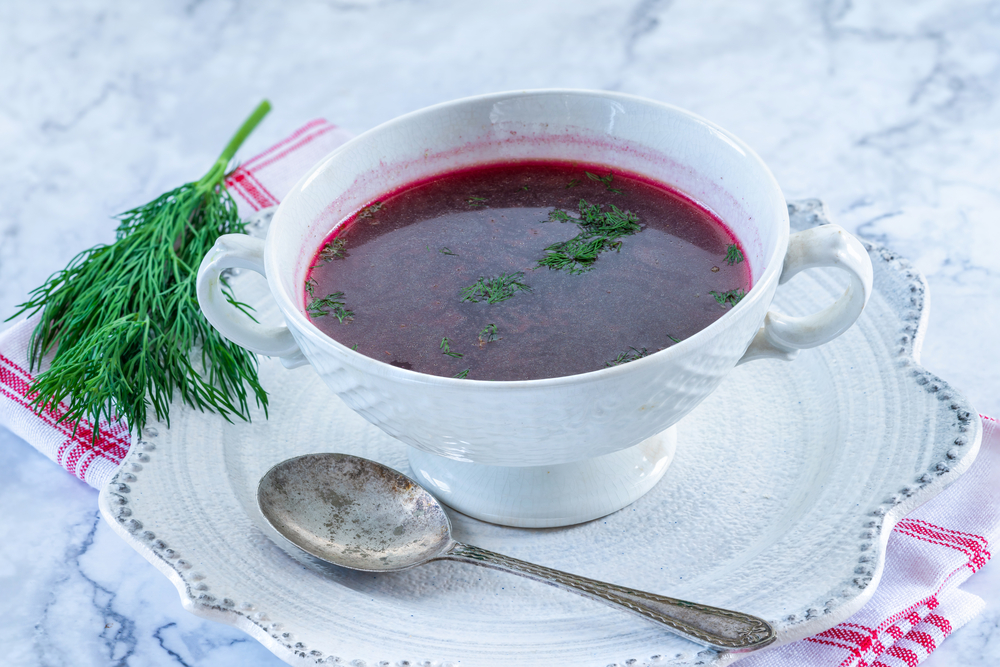Maybe you have heard of the Eastern European delicacy, borscht. This sour soup is made with beets and can be served cold or warm. Barszcz is the Polish word for borscht, yet the soup is a bit different.
The original recipe of borscht takes on an opaque purple hue and generally includes tomatoes, cabbage, and meat. In contrast, barszcz borders toward a basic beef broth that usually runs clear, whether white or red in color.
A Little About Borscht
Traditional Polish borscht is often made with a sour starter known as kvaas. Locals will often chill this starter and drink it like that. Think of it is as a tangy kombucha. If it is a Polish red borscht, the soup was made with fermented beets. If the barszcz has a white hue, however, it was made with fermented rye bread or rye flour.
This easy, translucent Polish soup recipe doesn’t require a sour starter. Many people would also use lemon juice or vinegar to get that desired sour taste. A delicious soup like this will warm your heart and tummy! Serve warm with boiled potatoes or eat cold with rye bread on the sides. Our version also uses sour cream.
The Variations of Borscht
Borscht barszcz is a popular soup consumed in many parts of Central and Eastern Europe. The main ingredients of the soup do tend to vary from one place to another, but one ingredient ties the whole thing together: fresh beets.
- Ukrainians cook the OG soup with cabbage, mushrooms, potatoes, tomatoes, and different beans.
- Russian borscht recipes commonly include potatoes, cabbage, and meat.
- Traditional Polish borscht is a Polish beet soup containing garlic, carrots, onions, and celery.
Regardless of which version you have, all of these are incredibly delicious recipes well worth the taste.
Often for this unique Polish beet soup recipe, the liquid is strained after the cook is completed to derive a pure, red broth. Polish recipes of this kind are a crowd-pleaser on Christmas.
Polish borscht is traditionally served with “little ear mushroom dumpling,” otherwise known as uszka for Polish Christmas Eve Dinner. Borscht soup served this way is called barszcz wigilijny. That, however, is not the borscht we mean today – this is a different barszcz recipe you will love.
The Recipe
- Prep Time: 10 minutes
- Cook Time: 20 minutes
- Total Time: 30 minutes
- Serves: 4 people
- Nutrition (Calories): 176 kcal
Ingredients
- 3 tablespoons butter
- 5 large garlic cloves, minced
- 6 cups beef stock, beef bones’ broth or vegetable stock
- 1 large yellow onion, diced
- 3 large carrots, cut into 1/2″ thick rounds
- 5 medium beets, peeled and cut into 1″ chunks (or, 2 cups canned beets)
- 2 celery stalks, cut into 1/2″ pieces
- 1 teaspoon caraway seeds
- 1/2 bay leaf/leaves
- 3 tablespoons apple cider vinegar
- 1/2 teaspoon allspice
- 2 teaspoons granulated sugar
- 1/4 teaspoon dried marjoram
- Salt and pepper, to taste
- Sour cream and dill, optional
The Cooking Process
Follow this step-by-step process properly to do justice to the recipe.
Step 1
Place a large heavy-bottomed pot over medium-high heat and melt the butter on it. Once the foams subside, add onion and cook until soft and clear (around 5 minutes). Add the garlic and cook for a minute or until fragrant.
Step 2
Scrape up any browned bits accumulating at the bottom of the pot before slowly adding the beef brother. Add beets, carrots, bay leaves, celery, allspice, marjoram, and caraway seeds. Bring to a boil (low) and keep cooking until the veggies go tender – about 10 to 15 minutes.
Step 3
Turn the heat off and discard the bay leaves. Add in the sugar, vinegar, salt, and freshly ground black pepper to taste.
Step 4
Pour soup into bowls and serve with fresh chopped dill and sour cream.
Borscht with Beet Kvass
In locals, this Polish beet soup is made using beet kvass instead of the beef concentrate or vinegar we mentioned. We recommend making the beef kvass five days in advance. Also, this kvass is salty, so you should use less salt toward the end of the recipe.
To do a beef kvass borscht, start as you would with veggie stock. Add all the vegetables of your choice along with apples, garlic, the kvass, and let it cook for 30 minutes. Add more kvass and seasoning as required.
Once you get the hang of it, Polish soups will easily become your and your family’s new favorite winter staple. After all, soup cuisine is loved around the world for a reason.
How to Achieve That Vibrant Red Color?
The reason we like adding vinegar and soup to our soup is that it prevents the occurrence of a pale, underwhelming, simple soup. Cooking the beets in stock or water for long would make the soup brown, and as good borscht has to be red, add a bit of sugar and tang at the end of the cook and combine everything.
The tang can come from a little white vinegar or lemon juice too. Make sure to salt and pepper properly!
Additional Tips
Some people like adding mashed potatoes to the side or dropping in cuts of cooked potatoes mid cooking for an added crunch. If you have a Dutch oven, use that to cook, and it should be fine. Make sure to use celery stalks, not celery roots. Separate the white and green parts.
We don’t like running this soup through an immersion blender, but that is a judgment call.
Conclusion
Amazing food can bring the whole family together, and Polish food specializes in that department. Our recipe developer went through multiple recipes of borscht before coming up with the perfect one.
In fact, this soup can easily be the main dish in any of your meals – a simple beet soup capturing the spotlight amongst all other recipes. This would be the perfect recipe to wish your loved ones a Merry Christmas or Happy Christmas Eve with!





 Based on 1 Review(s)
Based on 1 Review(s)





